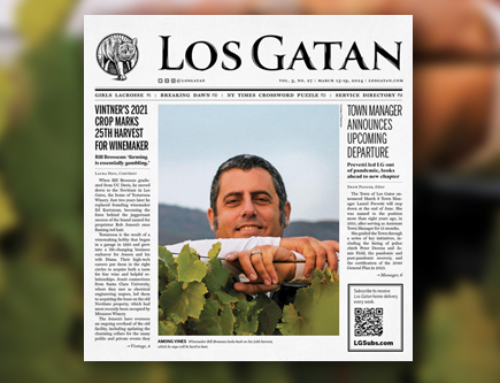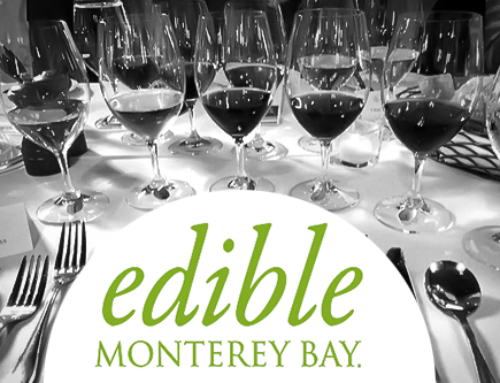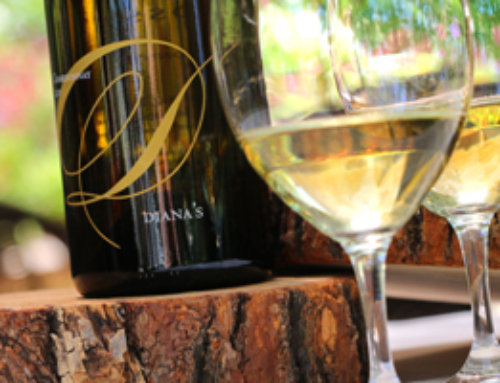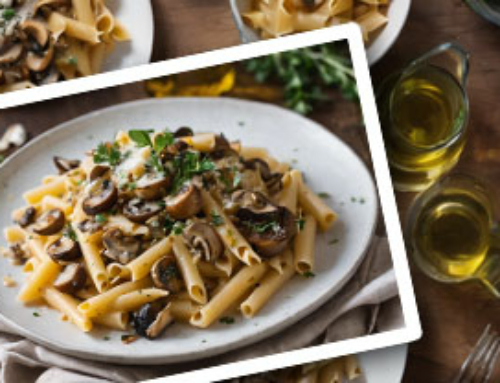
Nadiv Geiger, Chef de Cuisine
This was our first course dish at our Fall 2021 Harvest Dinner. It was so popular that we wanted to reprint it here! That evening it paired beautifully with our 2013 Rincon Vineyard Chardonnay, and it is sure to pair magically with any older Testarossa Chardonnays in your cellar.
A note from the chef: The key to this soup is using the best ingredients you can get your hands on. However, you can still make a really beautiful and delicious version using a semi-homemade approach. It is both deceivingly simple and complicated all at the same time. The second tip is to read the recipe before you go shopping! This way you can make some decisions on what will work best for you.
I will share with you how we make it here in our kitchen, but also give you some tips and tricks on how to speed up what takes us 2-3 days in our kitchen to as quick as 30-45 minutes for you at home.
I hope you enjoy making this at home as much as you enjoyed eating it!

Try pairing this with our Rincon Vineyard Chardonnay
Heirloom Bean & Escarole Soup
pancetta, sage, toasted pine nuts
Featured at our Fall 2021 Harvest Dinner
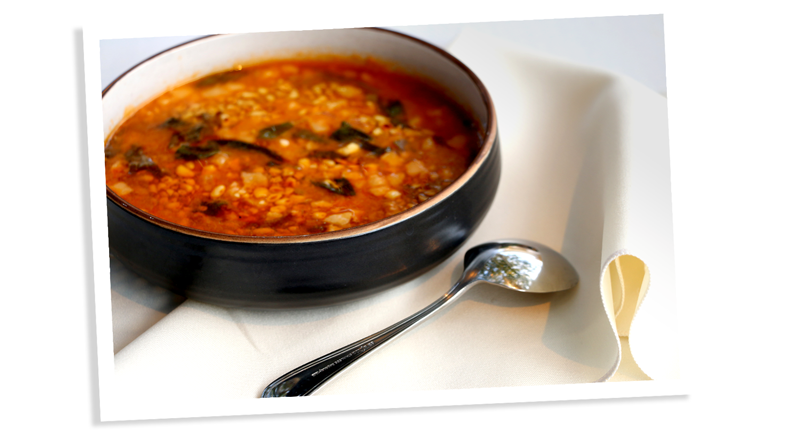
Serves 6-8
This will fill a medium sized pot with room for left overs
Ingredients
The Soup:
- 2 Lbs. Mixed Dry Beans or 8-9 12oz cans
Chef Tip: look for an equal mix of white/yellow beans: we use Mantequilla, Mayacoba, Marcella, and Large white Lima Beans for our recipe, but any thin skinned, white, tan, or yellow bean will do great (think canneline, butter beans, white navy beans etc.). We prefer Rancho Gordo as our source, which you can buy directly from their website and find in some stores, but any brand will do. To speed up this portion of the recipe get canned beans! See the list of beans above for what beans to get. You’ll want about 9 standard (10-12oz) cans worth of beans. You can always just use one type of bean if you’re having trouble finding a variety.
- 4 Qts-ish Water, really just enough to cover the beans with about 2in of space
- 1 Bunch Fresh Sage
- 1 ea Large Piece of Dried Kelp
Yes, we use kelp! It creates what the Japanese call Dashi, a wonderful light and delicious broth that adds a similar foundation of flavor to foods in the same way vegetable stock might. You can also use “HonDashi” which is a powdered mix that I would add later on or any vegetable soup base like the Osem Brand/Goya Brand/Other Consume powders, cubes or pastes.
- A splash Neutral oil, any vegetable oil/non flavored
- A Couple big Glugs Extra Virgin Olive oil
- 4 oz Pancetta (Italian cured pork belly), Diced as small as you can manage
- 4 oz Guancialle (Italian cured pork jowl), Diced as small as you can manage
For both the pancetta and Guancialle you can substitute your favorite bacon
- 1 ea Large Onion, we use Yellow, but honestly use whatever you have, even red onion
- 8 ea Garlic Cloves, minced, you can use pre minced jared (a couple heavy spoon fulls) or even tubes of mashed garlic (at home I really like to use the frozen cubes of mashed garlic made by the DOROT brand).
- 1 ea Large Carrot, peeled, cut into some smaller chunks
- 2 ea Celery Stalks, cut into some smaller chunks
For the onion, carrot and celery, feel free to buy those pre-cut containers in the salad section of your grocery store, one of those bigger containers should equal what you need; also you could get a bag of the frozen diced carrots/celery/onion mix if available to help speed things up.
- 4 spoonfuls Tomato Paste, 1 of those little cans would work
- 1 C White Wine, any, But I always prefer to cook with wine that I actually like to drink!
- To-Taste Salt
- 3 each Large Escarole Heads, Cut into large 1-2in chunks, wash well in water and pat dry
Cabbage is a good substitute. Napa cabbage would be closest, but any would do. You can also use gem lettuce or even buy a pre-shredded cabbage (or coleslaw mix!) in the salad section.
For the garnishes:
- 1 bunch Sage, pick the leaves
- Pine Nuts In Oil
- 1 C Pine Nuts, toasted
- 1 C Plain Olive Oil
- ½ C Koji (you don’t need this, but it’s what we did)
- A glug of Sesame Oil (you don’t need this, but it’s what we did)
Now that you have everything. Let’s Make Soup!!!
(If you bought canned beans, skip to step 6).
- If you bought dry beans you’ll need to soak them the day prior. Place the dry beans in a container 3x the volume of the beans (or use a few smaller containers and split them up). Cover the beans with twice as much water then there are beans and let them soak overnight.
- The next day, drain the beans from the water and place them in a pot twice the size then needed. A wider pot over a tall pot is preferred when cooking beans.
- Add the 4Qts-ish of water indicated in the ingredients list. Add the sheet of Kombu (dry kelp) (optional), and the bunch of sage with stems and all. The water should submerge the beans so that there is at least 2 inches of water over the beans. Add more water if needed.
- Turn your stove to medium heat and every so often stir. As the beans start to come up to a simmer remove and discard the kombu. You may notice a foam form on top, this is totally normal. All you need to do is use a large ladle or spoon and just scrape it off the top. Let your beans cook low and slow for about 2 hours, stirring every 10 or so minutes. If you need, add more water to the pot so that the beans stay continuously submerged.
- You’ll know they’re done when the largest beans are soft, tender and smooth in texture. Once they are cooked you can set them aside and begin the next phase
- (If you bought canned beans start at this step). In your food processor, combine the carrots, onion, celery and garlic. Pulse so that it becomes fine and almost paste-like, this is what we call the “SOFRITO”. Next grab a pot that will fit your soup. Place a splash of neutral oil with the diced cured pork you chose and set to medium heat. Let the pork render and get brown and crispy then add your sofrito.
- Once your sofrito has started to get a little color and be cooked, add the tomato paste. Stir the tomato paste around so that it is totally mixed in and let it cook for a minute or two.
- DEGLAZE. You probably have noticed that there’s some stuff now stuck to the bottom of the pan. Add the cup of wine and scrape with your spoon or spatula. This is called deglazing, the water in the wine reacts with all the yummy stuff stuck to the pan and allows it to release. Once the wine has cooked down to about 50% of it’s original volume you can add your beans! If using the canned beans, include the liquid in the cans and add the bunch of sage earlier used for the dry beans. If using the cooked beans, just pour it into the new pot (or you can do the steps above in a saute pan and add it to your soup pot that has the cooked beans in it).
- If you want to add “HonDashi” or any soup bouillon as described above, this is the time to do it! 1 packet of HonDashi or a large spoonful of Soup base will do. At this time also add a couple of big glugs of Extra virgin olive oil.
- Stir everything together and bring to a simmer. Grab a small container or bowl and take a couple of large cups worth of the beans out and smash them up with whatever you want (your hands, a spoon, a whisk, etc.)- just so that they’re smashed, it does not need to be perfect. Then add the mashed up beans back to the soup. This helps give the soup it’s body and texture.
- Allow 15-20 minutes for the flavors to come together and “marry”. It can sit on the stove at low temp for hours if you want, but it’s more or less done.
- Add your chopped Escarole (or cabbage or other substitute). Place it directly in the hot soup and watch it melt away.
- Taste your soup for seasoning, and salt and even black pepper if you’d like
Now we can work on the Garnishes
For the Crispy Sage
- You can do it either in your microwave (yes that’s right!) or in a small pan with oil. Just be careful because they will splatter. Simply heat enough neutral oil to medium-high heat (350° if you’re using a thermometer), add the sage, and stir. Once the oil stops aggressively bubbling they are done! Take them out of the oil and drain on paper towels. Season with a little salt.
If using the microwave: De-stem the sage leaves, and coat lightly with a tiny bit of oil, just enough to coat. Line a plate with a paper towel and spread the sage leaves out so that they don’t overlap. Microwave on full power for about 1-2 minutes depending on the power of your microwave until crispy. season with a little salt.
For the Pine Nuts in Oil
- IF you want to make “Koji Oil” then follow this first part, otherwise skip ahead. Combine the neutral oil with the Koji Rice in your blender. Blend on high/turbo for 5 Minutes. Place into a container with a lid and let it rest overnight. The next day, strain the oil to remove the rice particles and follow the next steps.
- (If you bought pre-toasted pine nuts skip ahead). Toast your pine nuts in your oven (or toaster oven if you have one) at 350° for about 5-10 minutes until golden brown. Make sure to stir them around at least once halfway through. You can also toast them in a pan but this can be very uneven. Once toasted, combine the HOT toasted pine nuts immediately with all the oils. Stir and let “marinate” for at least an hour before use.
Let’s Eat!
Pour hot soup into a bowl and garnish with a few crushed leaves of crispy sage, a couple spoonfuls of the pine nuts with the oil, and a couple cracks (or more) of fresh black pepper.
Pair with a glass (or two) of your favorite Testarossa Chardonnay.
ENJOY!
Nadiv Geiger
Chef de Cuisine


